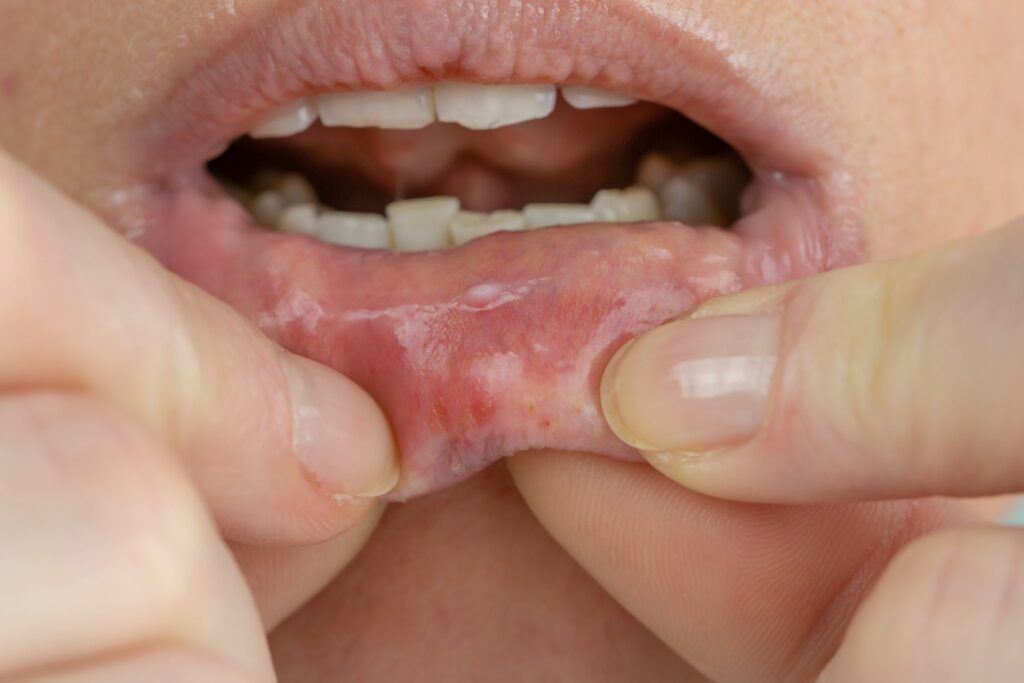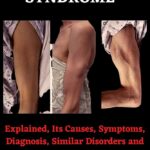Stomatitis refers to inflammation within the oral cavity, which may involve the lips, cheeks, tongue, gums, and roof or floor of the mouth. It is not a single condition but rather a clinical manifestation of various underlying causes, ranging from infections to systemic diseases. Patients may experience pain, redness, swelling, ulcers, and difficulty eating or speaking, severely affecting their quality of life.

Classification of Stomatitis
1. Aphthous Stomatitis (Canker Sores)
- Non-contagious, recurrent ulcers typically on the mucosal lining.
- Etiology may include stress, nutritional deficiencies (iron, B12, folate), or food allergies.
2. Herpetic Stomatitis
- Caused by Herpes Simplex Virus Type 1 (HSV-1).
- Presents as painful clusters of blisters followed by ulcers, often seen in children.
3. Denture-Related Stomatitis
- Resulting from poor denture hygiene or ill-fitting dental prostheses.
- Common in elderly patients and often associated with Candida albicans infection.
4. Allergic or Irritant Contact Stomatitis
- Triggered by contact with allergens or irritants such as toothpaste, dental materials, spicy foods, or alcohol.
5. Angular Stomatitis (Angular Cheilitis)
- Inflammation and cracking at the corners of the mouth.
- Linked to nutritional deficiencies, fungal infection, or mechanical irritation.
Causes and Risk Factors
The etiology of stomatitis is multifactorial:
| Category | Examples |
|---|---|
| Infectious | HSV-1, Coxsackievirus, Candida, Streptococcus |
| Autoimmune | Behçet’s disease, Lupus, Crohn’s disease |
| Nutritional | Iron, folate, or vitamin B12 deficiency |
| Allergic | Reactions to dental hygiene products or foods |
| Mechanical | Trauma from braces, dentures, or biting |
| Chemical/Thermal | Burns, tobacco, alcohol, or acidic foods |
| Medication-induced | Chemotherapy, antibiotics, NSAIDs |
Pathophysiology of Stomatitis
Stomatitis arises from inflammatory responses triggered by injury or immune dysregulation. When the mucosal barrier is compromised, pathogens and irritants penetrate deeper tissues, activating immune cells and inflammatory mediators. This results in ulceration, erythema, edema, and pain.
Clinical Presentation: Signs and Symptoms
Patients may exhibit a range of local and systemic symptoms, including:
- Painful sores or ulcers in the mouth
- Swollen, red mucosa
- Difficulty eating, swallowing, or speaking
- Burning sensation
- Fever (especially in herpetic and infectious forms)
- Halitosis (bad breath)
- Crusting at mouth corners in angular stomatitis
Diagnosis of Stomatitis
Clinical Evaluation
Initial diagnosis is typically clinical, based on the appearance, distribution, and recurrence of lesions.
Diagnostic Tests
| Test | Purpose |
|---|---|
| Swab culture | To identify bacterial or fungal pathogens |
| Tzanck smear | Confirms herpes virus infection |
| Blood tests | Evaluate for vitamin deficiencies or autoimmune markers |
| Biopsy | For persistent or atypical lesions |
Treatment Strategies for Stomatitis
General Management Principles
- Pain relief: Topical anesthetics (e.g., benzocaine, lidocaine)
- Inflammation control: Corticosteroid mouthwashes or gels
- Oral hygiene improvement: Antiseptic mouth rinses (e.g., chlorhexidine)
- Diet modification: Avoid spicy, acidic, or coarse foods
Targeted Therapies
| Cause | Treatment |
|---|---|
| Herpetic stomatitis | Acyclovir or Valacyclovir |
| Candidiasis | Nystatin, Clotrimazole |
| Aphthous ulcers | Topical steroids, sucralfate suspension |
| Nutritional deficiency | Vitamin/mineral supplementation |
| Allergic reactions | Removal of offending agent, antihistamines |
Denture Care
- Remove dentures at night
- Clean thoroughly using antifungal solutions
- Ensure proper fitting by a dental professional
Prevention and Long-Term Management
Preventive strategies are essential to minimize recurrence:
- Maintain excellent oral hygiene
- Use non-irritating dental products
- Stay hydrated and consume a balanced diet
- Avoid smoking, alcohol, and known food triggers
- Manage underlying systemic conditions
Stomatitis in Special Populations
Pediatric Patients
Children are more susceptible to herpetic gingivostomatitis, often with fever and irritability. Hydration and pain control are primary concerns.
Immunocompromised Individuals
Those undergoing chemotherapy, radiation, or living with HIV/AIDS are prone to opportunistic infections leading to severe stomatitis. Prophylactic antifungal or antiviral therapy may be indicated.
Complications of Untreated Stomatitis
Failure to address stomatitis may result in:
- Secondary bacterial infections
- Nutritional deficiencies due to eating difficulty
- Systemic spread of infection in immunocompromised individuals
- Chronic pain and scarring
- Speech impediments from repeated lesions
Frequently Asked Questions:
What is the most common type of stomatitis?
Aphthous stomatitis, or canker sores, is the most common form, affecting up to 20% of the population.
Can stomatitis be contagious?
Some forms, such as herpetic stomatitis, are contagious. Others like aphthous ulcers are not.
Is stomatitis a sign of cancer?
Not necessarily. However, non-healing or persistent ulcers should be evaluated to rule out oral cancer.
How long does stomatitis last?
Most mild cases resolve within 7 to 14 days. Chronic or recurrent forms may last longer and need medical management.
When should I see a doctor?
Seek medical attention if:
- Lesions persist for more than two weeks
- There’s severe pain or inability to eat
- Fever and systemic symptoms are present
Stomatitis represents a significant yet often underdiagnosed condition impacting oral health and systemic wellbeing. Early identification of the underlying cause, along with appropriate symptom management and prevention, is key to improving patient outcomes. A multidisciplinary approach, involving dentists, primary care providers, and specialists, ensures optimal care, particularly for chronic or recurrent forms.

